Chikuwa (ちくわ)

Japanese traditional food is always famous for their mouthwatering fish dishes such as sushi (寿司), sashimi (刺身), hitsumabushi (ひつまぶし), etc. With the creativity of Japanese people, they have created so many different types of dishes from fish and each one has its own unique taste. Among these, have you ever heard of Chikuwa? Today, we would like to introduce about this dish to find out what makes it so favoured!
What is Chikuwa?
Chikuwa is a type of Japanese traditional fishcake made by wrapping surimi (すり身) with seasonings around a bamboo stick and steaming or broiling it. Chikuwa is often used as ingredient in oden (おでん), udon (うどん), game-ni (がめ煮), chirashi sushi (ちらし寿司), yasai-itame (野菜炒め) – stir fry vegetables, etc. Moreover, there are also many Chikuwa products such as cheese Chikuwa, Chikuwa bread, Chikuwa salad,… that are easy to find at convenient stores, restaurants or supermarket.
Chikuwabu is another term refers to food product that is sometimes mistaken with chikuwa. Chikuwabu is wheat-based Japanese food item that is often used in oden. You can easily find it at convenient stores and specialty stores all across Japan.
What is surimi (すり身)?
Surimi is paste made from fish. As surimi is available in many forms, shapes and textures, surimi is broadly used as raw materials for Japanese dishes such as Kamaboko (蒲鉾), Chikuwa (ちくわ), Satsuma-age (さつま揚げ),… Beside the popular dishes, surimi also appears in local cuisine and soup (Tsumire soup). Meanwhile, in Europe and United States, crab-flavored and lobster-flavored surimi are favourite products and are now indispensable ingredients for salads and sandwiches. As the result, the consumption of these products are increasing in Europe and United States market.
Health info


Nutrients per 100g
The nutrients in Chikuwa differs depending on the choice of raw fish and producing method. Let’s take a look at the main nutrients of grilled chikuwa listed in the Standard Tables of Food Composition in Japan 2015 (Seventh revised edition) by the Ministry of Education, Culture, Sports, Science and Technology (MEXT):
| Nutrients of grilled chikuwa (per 100g) | |
| Energy | 121 kcal |
| Protein | 12.2g |
| Fat | 2g |
| Carb | 13.5g |
| Calcium | 15mg |
| Iron | 1mg |
| Salt | 2.1g |
Because chikuwa’s main ingredient is white fish (to make sumiri), it is relatively low in fat and high in protein. However, since salt is mixed in to make the paste, the amount of salt is quite high.
Use chikuwa instead of protein bars
With people who exercises and are going on a diet, have a healthy and well-balanced meal is really important. They have to take great care not to fall into protein deficiency. Therefore, these people have to pay atten to food that can provide protein such as meat, fish, soy products, eggs. One solution is protein bars which are in form of snaks or jelly drinks so that people can easily buy and carry them anywhere.
As chikuwa is made from fish, it is one of the food that you can take in protein. If you want to use chikuwa instead of protein bars, let’s keep in mind that chikuwa has a lower energy content and can be efficiently ingested with protein. However, the amount of salt is more 6 times than a protein bar so if you eat it too often, you will result in taking in too much salt. Therefore, in case you want to supplement protein with chikuwa, do not forget to reduce the salt amount intake from your diet.
History of Chikuwa
Chikuwa is actually one of the ingredients with the oldest history. When talking about the history of it, it is also necessary to mention “kamaboko”. There are various theory about the origin of kamaboko, but in “Ruijuzoyosho”, an ancient book from the Heian period, there are traces of “kamaboko” and a dish similar to chikuwa. According to the picture in the book, mashed fish was grilled on a bamboo stick and seved as one of the fish dishes. For this reason, the food called “kamaboko” has existed since ancient times. After that, references to kamaboko have been confirmed in documents from the Muromachi period. According to the documents, surimi of fish wrapped around a bamboo stick and roasted over a fire was name “kamaboko” because it resembled to the “gama-no-ho” (蒲の穂) plant.
During that time, kamaboko was a luxury dish and was mainly eaten by aristocrats. However, as time passes by, the item luxury gradually changed and from the Edo period, even ordinary people could eat it. Over the long period of history, a variety of food products using minced fish appeared so the name “chikuwa” was born to dishtinguish from the original kamaboko. Chikuwa (竹輪 ちくわ) means “bamboo ring”, it is so called because it resembles the cut end of a bamboo stalk. In fact, “kamaboko” that was mentioned in the history is the prototype of chikuwa that we know today.
Various types of Chikuwa
Types of Chikuwa
Chikuwa can be broadly divided into raw chikuwa and grilled chikuwa.


Raw chikuwa
This type is thin and short with a dark brown color in the center and white color at the end. The fish used as raw materials are Alaska pollock and golden threadfin bream. These fishes are suitable for eating raw so you can eat chikuwa as-is or use for salads.
Grilled chikuwa
This type one is thick and long and is mainly used for simmered dishes and oden. In addition to Alaska pollock and threadfin bream, people also use horse mackerel as raw materials.
While people often use this type fish cake in oden, it may surprise you that there are some differences between normal chikuwa and chikuwa in oden (grilled one). The keys for these differences are hidden in the manufacturing process. Raw chikuwa (normal chikuwa) is slowly roasted at about 200℃ to create a “skin” on the surface of the product. By this technique, you will get to experience the crunchy texture of the food. On the other hand, people spread oil on a part of the grilled fish cake so that when grilling, only that oiled part will be browned, making a very unique pattern. In addition, this way also make the umami flavor easier to dissolve into the soup and enhance the flavor of oden.
Popular regional chikuwa
Although chikuwa is famous all over Japan, there are some regions with their unique chikuwa that you can not find anywhere else. Let’s go and find out what is interesting about the regional chikuwa!
Tofu chikuwa
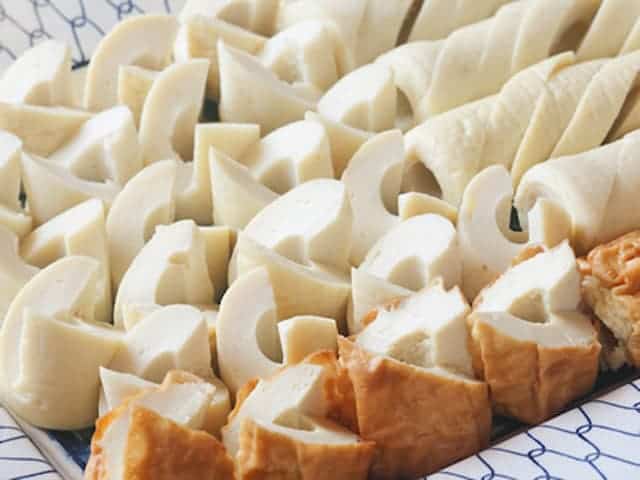

This is a special product of Tottori Prefecture with the unusual material combination of momen tofu and white fish meat in a ratio of 7:3. Instead of grilling, tofu chikuwa is steamed so this dish is unique by its white appearance. Compared to others, Tottori products is rich in protein and low in calories.
Ago-chikuwa


Another special product of Tottori prefecture made from chikuwa. In Japanese, “Ago” is the dialect around Nagasaki and it means flying fish, the seasonal fish of June and July. Ago-dashi is dashi from dried flying dish and this dashi has a refined taste and flavor. This specialty of Tottori is made from this ago-dashi and has a firm skin and chewy texture.
Noyaki Chikuwa
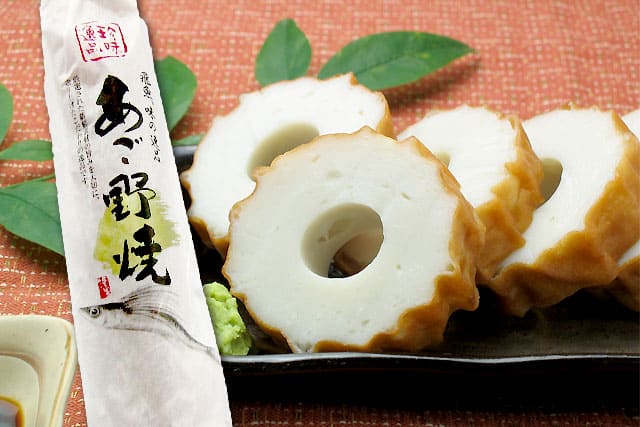

Ago Noyaki Chikuwa (アゴ野焼きちくわ) from Matsue City, Shimane Prefecture is a high-class chikuwa made from “ago” that we just mentioned above. Ago chikuwa is often thicker than regular chikuwa and is characterized by grilled marks all over the chikuwa.
Take Chikuwa
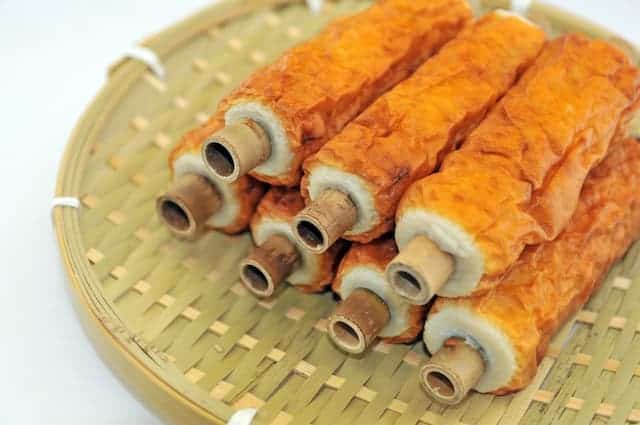

Take Chikuwa is favourite cuisine in Tokushima prefecture. This product is grilled with minced fish meat on a short bamboo stick and is sold without removing the bamboo stick. The dishtinguishable characteristic of Take Chikuwa is to hold the stick and eat as-is. It is also perfect as cocktail snack with the amazing texture.
Shrimp Chikuwa


Shrimp Chikuwa is specialty of Ehime Prefecture which has the unique pink color and thick texture. The main ingredients of shrimp chikuwa is homemade tofu, minced white fish and shrimp from Setouchi area. It is recommended to eat it with wasabi or soy sauce. In addition, you can also use it as ingredients for miso soup.
Botan Chikuwa


Botan Chikuwa (牡丹ちくわ) means peony chikuwa and is produced only in Aomori prefecture. Using a special method, the pattern in botan chikuwa is similar to the petals of peony flower. For this reason, this specialty from Aomori is called “Botan Chikuwa”.
How to make Chikuwa?
As Chikuwa is a popular dish and you can find it at convenient stores or supermarket, it will be a more interesting experience to make it by yourself. You can make it to eat it as-is or use as ingredients for oden, nimono, etc.
Recipe
| Ingredients | |
| White fish (sea bream and cod) | 300g |
| Salt | 3g |
| Frozen egg white | |
| Sugar | 9g |
| Starch | 9g |
| Ice | 3 pieces |
| Sake | 1/2 tbsp |
| Other ingedients | |
| Cucumber | |
| Cheese | |
| Carrots |
How to make Chikuwa?
- Remove the bones and skin from the fish. Make sure there is no bone left.
- Cut the cod fish into 3cm squares.
- Combine the sea bream and small pieces of cod together.
- Wash quickly with ice water to get rid of fish oil smell and then drain the water with a sieve.
- Take the fish out of water and put into a tray. Cover with paper to remove the water.
- Wrap the fish by the wrapper and keep the tray in the freezer.
- Put the half-frozen sea bream and cod into the food processor.
- Add salt, frozen egg white, sugar, potato starch and 3 ice cubes. Remember to use the food processor that can cut ices.
- Switch the food processor on and use a pulse function and repeat 2-3 times until the texture is smooth.
- Finally, add sake to adjust the firmness so that it will be easier to wrap arounf the bamboo later. Surimi is now complete!
- Take out 1/3 if the surimi and place on a flat surface.
- Stretch it into a rectangle with the length of about 10cm. Make the thickness as flat as possible.
- Place a bamboo stick on the edge of the surimi and wrap it around the bamboo. Be careful not to make the surimi peeled off.
- Wet you fingers and shape the Chikuwa.
- Grill the chikuwa slowly and rotate the bamboo little by little so that the chikuwa brown nicely. When the chikuwa turns into a beautiful baked color, let it cools down for a while.
When the chikuwa cools down, you have finished the dish! Remove the bamboo stick or just eat as-is with the bamboo stick if you like. Itadakimasu!
Stores and Restaurants
Making and enjoying chikuwa at home seems fun. But if you do not have enough confidence in your cooking skills, or it’s just you are too busy for making it on your own, it would be a great idea to find some stores where you can rely and stop by on your way home to buy some chikuwa.
Yamasa Chikuwa (やまさちくわ)


Yamasa Chikuwa’s main store is in Uomachi, Toyohashi city, which used to be a lively fish market. Starting as a fish wholesaler when founded, Yamasa Chikuwa now becomes a popular stores where you can find a wide variety of products like chikuwa and kamaboko. Especially, the main store has a limited item called “Yakikamoboko with scallops” which contains plenty of fresh scallop. Beside chikuwa, we also recommend you try this product for once as the amazing taste will last long in your mind.
Surimiya (すりみや)


Surimiya is a Japanese restaurant that sells nabe (Japanese style hot pot) and oden. There are a lot of amazing dishes such as oden, satsuma-age and chikuwa. The soup is good and combine very well with the freshly grilled chikuwa. If you want an enjoyable dinner with family and friends, this would be a really nice choice.
Chimura – Motoucho main store (ちむら 元魚町本店)
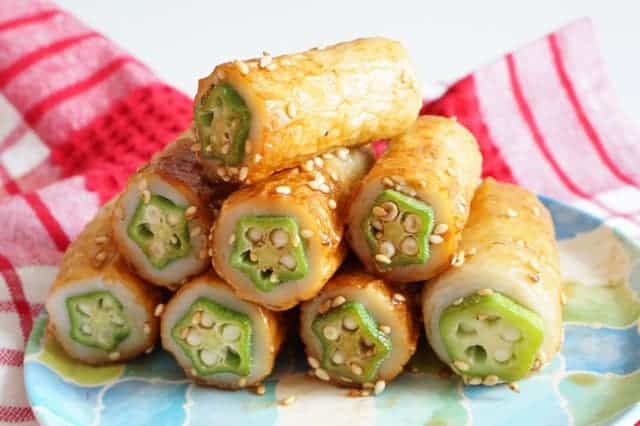

This is the main store of Tottori Chimura that sells tofu chikuwa – specialty of Tottori prefecture. Motoucho has a long history and this is where you can enjoy the real-taste of Tottori tofu chikuwa. Beside the food, the restaurant also serve drinks such as beer, sake or tea. There are also some stores of Chimura in Tottori. You can access the website and where the most convenient restaurant to go and enjoy!
Tora-ya kamaboko (とらや蒲鉾店)
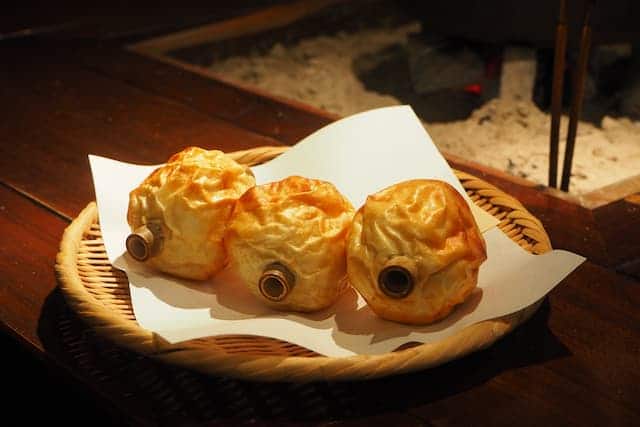

Founded in 1969, Toraya made and sold chikuwa at Hinagu onsen, Kumamoto Prefecture. The store becomes more and more popular and eventually turns into a specialy “Hinagu Chikuwa”. Until now, Toraya is still a popular store where you can enjoy the special chikuwa from Kumamoto. If you get a chance to come to Yatsushiro city, do not forget to come over here!
Takeaway
As Japanese traditional fish cake, chikuwa is popular all over Japan as well as overseas. It is used in a lot of dishes as oden, nabe, yasai-itame and so on. Chikuwa is just a simple dish but the good taste of it is undeniable. How about stopping by a store, buying some chikuwa for yourself and putting it into your udon? That is so amazing experience for a cold winter day!
If you want to find out more about Japanese fish cake, click here to get information about Kamaboko.








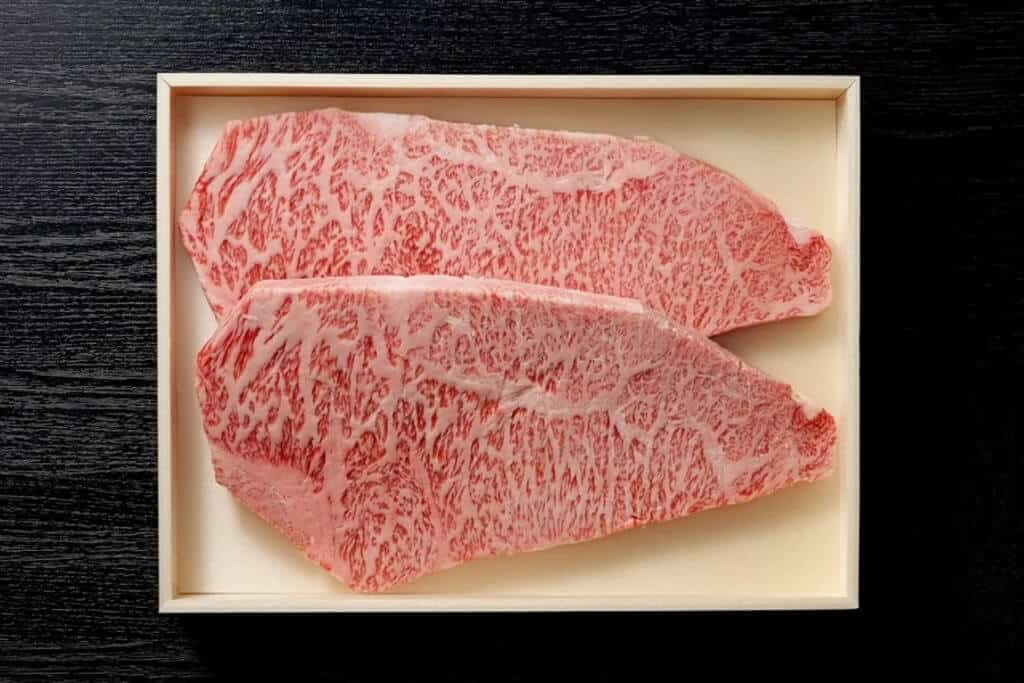




Comments